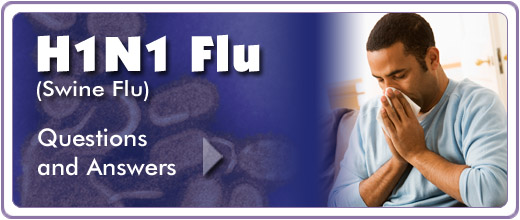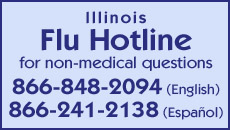
| Health Care Providers |
H1N1 Flu Home |
Interim Guidelines on Distribution of Antivirals (May 1, 2009)
Instructions for Respiratory Virus Specimen Submission- PDF
Communicable Diseases Laboratory Test Requisition - PDF
Special Considerations for Children
Aspirin or aspirin-containing products (e.g. bismuth subsalicylate – Pepto Bismol) should not be administered to any confirmed or suspected ill case of swine influenza A (H1N1) virus infection aged 18 years old and younger due to the risk of Reye syndrome. For relief of fever, other anti-pyretic medications are recommended such as acetaminophen or non steroidal anti-inflammatory drugs.
This is an official CDC Health Update
Interim Guidance—Children and Pregnant Women who may be Infected with Swine-Origin Influenza Virus: Considerations for Clinicians
Today CDC issued new interim guidance for clinicians on how to care for children and pregnant women who may be infected with a new influenza virus of swine origin that is spreading in the U.S. and internationally. Children and pregnant women are two groups of people who are at high risk of serious complications from seasonal influenza.
New Interim Clinical Guidance for the Treatment of Children
Little is currently known about how swine-origin influenza viruses (S-OIV) may affect children. However, we know from seasonal influenza and past pandemics that young children, especially those younger than 5 years of age and children who have high risk medical conditions, are at increased risk of influenza-related complications.
Illnesses caused by influenza virus infection are difficult to distinguish from illnesses caused by other respiratory pathogens based on symptoms alone. Young children are less likely to have typical influenza symptoms (e.g., fever and cough) and infants may present to medical care with fever and lethargy, and may not have cough or other respiratory symptoms or signs.
The new interim guidance for clinicians on the prevention and treatment of swine influenza in young children is available at http://www.cdc.gov/swineflu/childrentreatment.htm
New Interim Clinical Guidance for the Treatment of Pregnant Women
Evidence that influenza can be more severe in pregnant women comes from observations during previous pandemics and from studies among pregnant women who had seasonal influenza. An excess of influenza-associated deaths among pregnant women were reported during the pandemics of 1918–1919 and 1957–1958. Adverse pregnancy outcomes have been reported following previous influenza pandemics, with increased rates of spontaneous abortion and preterm birth reported, especially among women with pneumonia. Case reports and several epidemiologic studies conducted during interpandemic periods also indicate that pregnancy increases the risk for influenza complications for the mother and might increase the risk for adverse perinatal outcomes or delivery complications.
The new interim guidance for clinicians for the treatment of influenza in pregnant women is available at http://www.cdc.gov/swineflu/clinician_pregnant.htm
Background
Human infections with the newly identified S-OIV that is spreading among humans were first identified in April 2009 with cases in the United States and Mexico. The epidemiology and clinical presentations of these infections are currently under investigation. There are insufficient data available at this point to determine who is at higher risk for complications of S-OIV infection. However because pregnant women and children are known to be at higher risk for complications during seasonal influenza complications and during prior pandemics, it is reasonable to assume that these groups of people may be at higher risk for complications from infection with this new virus.
Additional Information
For additional information about the current influenza outbreak, see:
http://www.cdc.gov/swineflu/
For additional information about CDC’s investigation of the current H1N1 outbreak, see http://www.cdc.gov/swineflu/investigation.htm
This information is also available by calling 1-800-CDC-INFO.
For more information about swine flu: http://www.cdc.gov/swineflu
Additional information is also available by calling 1-800-CDC-INFO (1-800-232-4636)
Update: Novel Influenza A (H1N1) Virus Infections --- Worldwide, May 6, 2009
MMWR, Dispatch - Update: Swine Influenza A (H1N1) Infections --- California and Texas, April 2009 - PDF
CDC Guidance Documents
Prevention of Disease Transmission in the Dental Healthcare Setting
Tamiflu Flyer (updated 4/29/09 with CDC guidelines) - PDF
Interim Guidance on Antiviral Recommendations for Patients with Confirmed or Suspected Swine Influenza A (H1N1) Virus Infection and Close Contacts
Swine Inflenza Virus Biosafety Guidelines for Laboratory Workers
Interim Guidance - HIV-Infected Adults and Adolescents: Considerations for Clinicians Regarding Swine-Origin Influenza A (H1N1) Virus
Interim Guidance for Infection Control for Care of Patients with Confirmed or Suspected Swine Influenza Virus Infection in a Healthcare Setting
Interim Additional Guidance for Infection Control for Care of Patients with Confirmed, Probable, or Suspected Novel Influenza A (H1N1) Virus Infection in Outpatient Hemodialysis Settings
Interim Guidance on Case Definitions for Swine Influenza Human Case Investigations
Interim Guidance for Clinicians on Identifying and Caring for Patients with Swine-origin Influenza A (H1N1) Virus Infection
Interim Guidance on Specimen Collection, Processing, and Testing for Patients with Suspected Swine-Origin Influenza A (H1N1) Virus Infection
Swine Flu: Emergency Use Authorization (EUA) of Medical Products and Devices
Interim Guidance—Pregnant Women and Swine Influenza: Considerations for Clinicians
Interim Guidance for Use of 23-Valent Pneumococcal Polysaccharide Vaccine During Novel Influenza A (H1N1) Outbreak
Previous Conference Calls
|
|
|

www.flu.gov
U.S. Department of
Health & Human Services’
influenza Web site
| Illinois H1N1 Flu Case Summary |
| Counties |
Confirmed and Probable Cases |
Deaths |
| 42 |
3,425 |
17 |
Illinois Cases of H1N1 Flu by County
(As of July 31, 2009, 10 a.m.)
Updated on Fridays |
City or
County |
# of
Probable Cases |
# of
Confirmed Cases |
Total |
| Boone |
- |
10 |
10 |
| Champaign |
- |
1 |
1 |
| Chicago |
9 |
1,574 |
1,583 |
| Coles |
- |
1 |
1 |
| Cook |
17 |
972 |
989 |
| DeKalb |
- |
2 |
2 |
| DeWitt |
- |
1 |
1 |
| DuPage |
- |
147 |
147 |
| Effingham |
- |
2 |
2 |
| Fayette |
- |
1 |
1 |
| Franklin |
- |
2 |
2 |
| Grundy |
- |
2 |
2 |
| Henry |
- |
2 |
2 |
| Jackson |
- |
1 |
1 |
| Jo Daviess |
- |
1 |
1 |
| Kane |
5 |
86 |
91 |
| Kankakee |
1 |
28 |
29 |
| Kendall |
- |
6 |
6 |
| Knox |
- |
3 |
3 |
| Lake |
5 |
249 |
254 |
| LaSalle |
- |
8 |
8 |
| Madison |
- |
5 |
5 |
| McDonough |
- |
3 |
3 |
| McHenry |
- |
14 |
14 |
| McLean |
- |
2 |
2 |
| Mercer |
1 |
2 |
3 |
| Monroe |
- |
1 |
1 |
| Ogle |
- |
4 |
4 |
| Peoria |
- |
3 |
3 |
| Piatt |
- |
1 |
1 |
| Putnam |
- |
1 |
1 |
| Richland |
- |
2 |
2 |
| Rock Island |
- |
24 |
24 |
| Sangamon |
- |
3 |
3 |
| St. Clair |
- |
4 |
4 |
| Stephenson |
- |
3 |
3 |
| Tazewell |
- |
1 |
1 |
| Union |
- |
1 |
1 |
| Warren |
- |
2 |
2 |
| Whiteside |
- |
2 |
2 |
| Will |
- |
152 |
152 |
| Williamson |
- |
5 |
5 |
| Winnebago |
- |
47 |
47 |
| Undetermined |
- |
6 |
6 |
| Total |
38 |
3,387 |
3,425 |
Locations may change as the result of additional information obtained through case investigations.
A confirmed case is defined as a person with an acute febrile respiratory illness with laboratory confirmed infection.
A probable case is defined as a person with an acute febrile respiratory illness who is positive for influenza A, but negative for H1 and H3.
The reported number of " probable and confirmed" cases do not reflect the overall incidence of H1N1 influenza in Illinois because CDC and the Illinois Department of Public Health are not emphasizing testing of patients with mild illness. Most individuals with novel influenza H1N1 infection have mild illness and are not being tested.
Since the number of Illinois cases listed represent a weekly update, the totals may not always be consistent with those reported by local health departments. If there is a discrepancy between the state and local health department counts, data from the local health departments should be used as the most accurate number.
|

|
|


